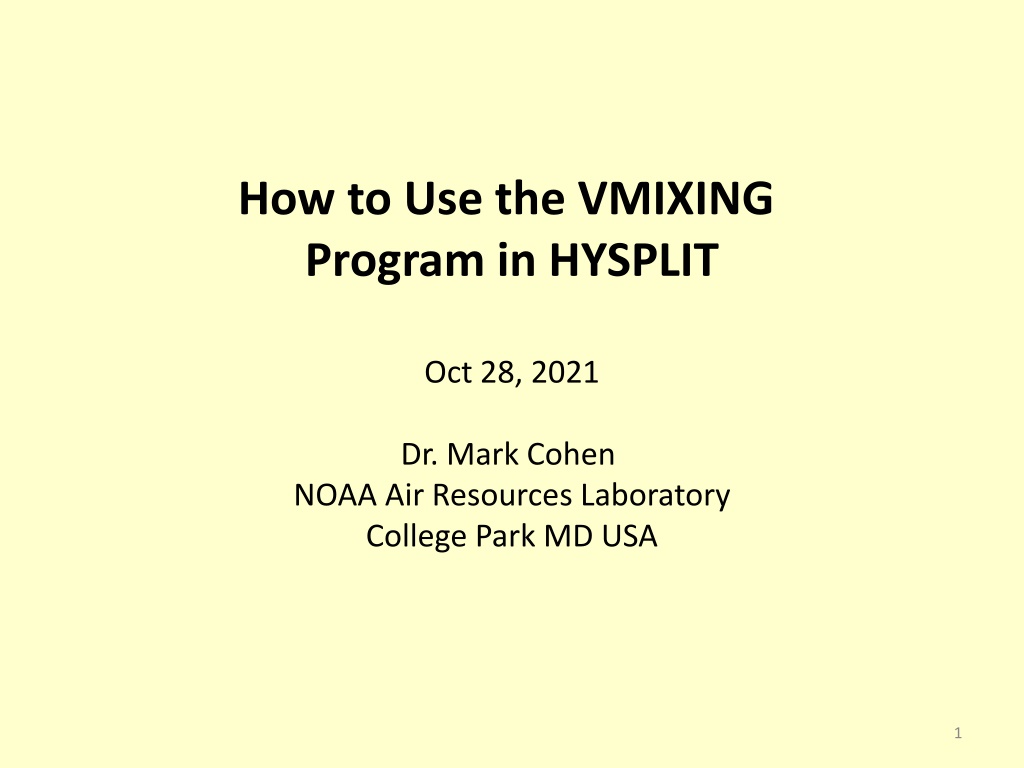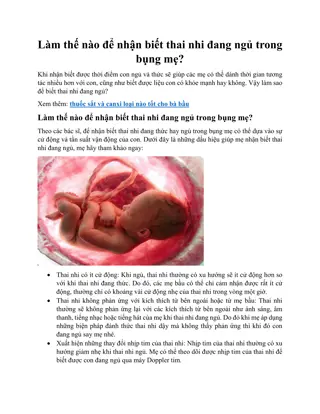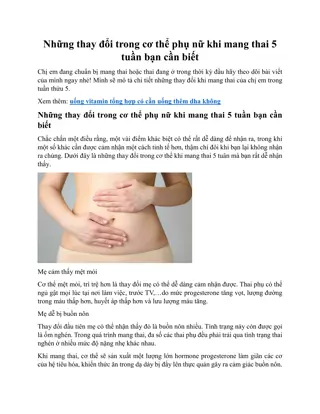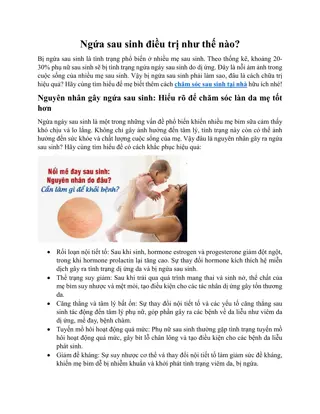How to Use the VMIXING Program in HYSPLIT
The VMIXING program in HYSPLIT allows for analysis of meteorological stability parameters via command line arguments. Learn how to use VMIXING with provided examples. Discover how to specify process IDs for program execution and setup file requirements.
Download Presentation

Please find below an Image/Link to download the presentation.
The content on the website is provided AS IS for your information and personal use only. It may not be sold, licensed, or shared on other websites without obtaining consent from the author.If you encounter any issues during the download, it is possible that the publisher has removed the file from their server.
You are allowed to download the files provided on this website for personal or commercial use, subject to the condition that they are used lawfully. All files are the property of their respective owners.
The content on the website is provided AS IS for your information and personal use only. It may not be sold, licensed, or shared on other websites without obtaining consent from the author.
E N D
Presentation Transcript
How to Use the VMIXING Program in HYSPLIT Oct 28, 2021 Dr. Mark Cohen NOAA Air Resources Laboratory College Park MD USA 1
There is a program called vmixing that is present in the exec directory of HYSPLIT Its use is somewhat different than most other programs in the exec directory, as will be shown below Here, a basic introduction to the use of the vmixing program is provided, along with some example scripts. Previous versions of this tutorial only included Windows DOS Batch scripts, but in the Nov 2019 update, Linux Korn Shell script examples have also been included. This tutorial has been carried out with HYSPLIT v5.3.0 (Nov 2021) but should also work with previous versions as well, although the relatively new TKE-output feature may not be present for very old versions, as it was added in 2018. There is a related program in HYSPLIT called profile (see Appendix 1) 2
At present, the vmixing program can only be run from the command line (or via a script). There is no option to run the program from the Graphical User Interface (GUI) Vmixing allows for six different command line arguments (-p, -s, -t, -a, -m, -w): C:\hysplit4\working>..\exec\vmixing Creates a time series of meteorological stability parameters USAGE: vmixing (optional arguments) -p[process ID] -s[KBLS - stability method (1=default)] -t[KBLT - PBL mixing scheme (2=default)] -a[CAMEO optional variables (0[default]=No, 1=Yes, 2=Yes + Wind Direction] -m[TKEMIN - minimum TKE limit for KBLT=3 (0.001=default)] -w[an extra file for turbulent velocity variance 0[default]=No,1=Yes)] Note that due to a typo in the vmixing code, the newly added w option does not work as intended. Now, with w0, a fort.50 output file is written with no header And now, with w1, a header file vmix.process_id.txt is written but does not have the requested data. The problem is now fixed. A fully functional vmixing program (i.e., with the w option working) will be included in the next release. 3
One crucial argument is "-p" (the process id). Whatever is given as the process id governs the execution of the program by determining what CONTROL and SETUP file are used If the process id is given as "nothing"*, then the program looks in the working directory for CONTROL and if its present, SETUP.CFG ..\exec\vmixing p * note that in this case, you still must include the p if you don't the program will just return the command line options If the process id is specified, e.g., "RUN_01", then the program looks in the working directory for CONTROL.RUN_01 and if its present, SETUP.RUN_01 ..\exec\vmixing pRUN_01 A CONTROL file with the appropriate name (and corresponding SETUP.CFG file with the appropriate name, if desired) must be present, i.e., you have to establish this file (or files) one way or another before you run vmixing 4
In the following, we will run the vmixing program to analyze one month of data (June 2012) from the NCEP/NCAR 2.5 degree global reanalysis If you want to try to duplicate this analysis, you will have to download the met data file from the ARL archive. Here is a direct URL to the data file (if you click the link, you can save the file to your local computer). You will need to know what directory you saved it in to include in the CONTROL file. This binary file is ~114 MB in size. ftp://arlftp.arlhq.noaa.gov/pub/archives/reanalysis/RP201206.gbl On the following page is a basic CONTROL file that can be used to run vmixing on this example file. You will need to adjust the 2nd to the last line in the file to match your met file directory 5
an example CONTROL file to analyze one month of NCEP/NCAR 2.5 degree global reanalysis data (June 2012) Starting year, month, day, hour all zeros means start at beginning of met file 00 00 00 00 1 Number of starting locations Lat, Long, Height of each starting location As shown in Appendix 2, use a starting height of 0 m above ground level 39.028 -76.817 0.0 9999 Number of hours to create the vmixing output; this can be a large number to make sure you get all times in the met file 0 Vertical motion option 25000.0 Top of model domain (meters) 1 Number of meteorological data files to use D:\METDATA\global_reanalysis\ Directory and then name of met file the directory has to be adjusted for your particular situation, i.e., where you put this met data file RP201206.gbl 6
For most executables in the hysplit\exec\ directory, if you run the program by typing in its name and hitting enter, with no other arguments on the command line, it will give you a list of the arguments that it either needs or could use! These are the arguments that can (or must) be specified if running the program from the command line or from a script C:\hysplit\working_vmixing_tutorial>..\exec\vmixing Creates a time series of meteorological stability parameters USAGE: vmixing (optional arguments) -p[process ID] -s[KBLS - stability method (1=default)] -t[KBLT - PBL mixing scheme (2=default)] -a[CAMEO optional variables (0[default]=No, 1=Yes, 2=Yes + Wind Direction] -m[TKEMIN - minimum TKE limit for KBLT=3 (0.001=default)] -w[an extra file for turbulent velocity variance (0[default]=No,1=Yes)] C:\hysplit\working_vmixing_tutorial> 7
Here's the terminal session in Windows, where we run the vmixing program using the CONTROL file above. The items typed by the user are in red C:\hysplit\working_vmixing_tutorial>dir CONTROL Volume in drive C is OS Volume Serial Number is 74EF-A490 Directory of C:\hysplit\working_vmixing_tutorial 11/19/2019 03:40 PM 106 CONTROL 1 File(s) 106 bytes 0 Dir(s) 219,560,742,912 bytes free C:\hysplit\working_vmixing_tutorial>..\exec\vmixing p 6 360.0000 9999 9999 12 6 1 0 0 59124960 12 6 1 6 0 59125320 . . . 12 6 30 6 0 59167080 12 6 30 12 0 59167440 Output while vmixing is running, one line for each time in met file C:\hysplit\working_vmixing_tutorial>dir stability.txt Volume in drive C is OS Volume Serial Number is 74EF-A490 Directory of C:\hysplit\working_vmixing_tutorial 11/19/2019 03:40 PM 12,960 STABILITY.txt 1 File(s) 12,960 bytes 0 Dir(s) 219,565,789,184 bytes free C:\hysplit\working_vmixing_tutorial> 8
On the next page is the output created, written to a file called "STABILITY.txt" (if we had specified a process id, it would have gone after the dot. For example, STABILITY.RUN_01.txt.) You can see that there is a record for each 6 hr time period in the file*, and values are provided for the following variables: parameter abbrev units notes Pasquill-Gifford Stability Category PSQ Mixing Height Zi m the value written to the output file is 10x the actual Kz value m2/s Vertical Mixing Coefficient Kz Friction Velocity U* Zo Zterr Kh m/s Roughness Length m Terrain Height m m2/s Horizontal Mixing Coefficient * There is not a record for the last time period in the file, June 30, 2012, 18z. This is because when vmixing runs (like HYSPLIT) it needs the next time period to be available to do any calculations for a given time period. So, if you want to get the "last" time period in a given file, you need to include the next file (or at least the next time step). 9
Here's a graph showing the values for the selected site, output from vmixing, for RP201206.gbl 100000 Zi (m) 10xKz (m2/s) 10000 Zo (m) Zterr (m) 1000 Kh (m2/s) The roughness length (Zo) and terrain height (Zterr) are essentially constant, as would be expected for a given site. 100 10 However, you can see a large diurnal (and day to day) variation for the mixing height (Zi) and mixing coefficients (Kz and Kh). 1 0.1 0.01 6/1/2012 6/2/2012 6/3/2012 6/4/2012 6/5/2012 6/6/2012 6/7/2012 6/8/2012 6/9/2012 7/1/2012 6/17/2012 6/30/2012 6/10/2012 6/11/2012 6/12/2012 6/13/2012 6/14/2012 6/15/2012 6/16/2012 6/18/2012 6/19/2012 6/20/2012 6/21/2012 6/22/2012 6/23/2012 6/24/2012 6/25/2012 6/26/2012 6/27/2012 6/28/2012 6/29/2012 11
Here's a graph showing the same values for the selected site, output from vmixing, for RP201206.gbl, for just one week 100000 Zi (m) 10xKz (m2/s) 10000 Zo (m) Zterr (m) 1000 Kh (m2/s) The roughness length (Zo) and terrain height (Zterr) are essentially constant, as would be expected for a given site. 100 10 However, you can see a large diurnal (and day to day) variation for the mixing height (Zi) and mixing coefficients (Kz and Kh). 1 0.1 0.01 6/1/12 0:00 6/1/12 6:00 6/2/12 0:00 6/2/12 6:00 6/3/12 0:00 6/3/12 6:00 6/4/12 0:00 6/4/12 6:00 6/5/12 0:00 6/5/12 6:00 6/6/12 0:00 6/6/12 6:00 6/7/12 0:00 6/7/12 6:00 6/8/12 0:00 6/3/12 18:00 6/5/12 12:00 6/1/12 12:00 6/1/12 18:00 6/2/12 12:00 6/2/12 18:00 6/3/12 12:00 6/4/12 12:00 6/4/12 18:00 6/5/12 18:00 6/6/12 12:00 6/6/12 18:00 6/7/12 12:00 6/7/12 18:00 12
In the above, we were running vmixing from the command line, and creating the CONTROL files with a text editor. However, vmixing can be run with scripts. A few examples of running vmixing with scripts using a "RUN" and "SET" architecture were created and included in the "working_vmixing_001" files associated with this tutorial. We have included DOS Batch script examples (.bat files that can be run with Windows), and we have included Korn Shell scripts which can be run on Linux and Mac environments. As with the command line approach, scripts must be run from the terminal. If you are not familiar with the terminal, a brief introduction is given in Appendix 3. In vmixing_run_001.bat (and .ksh) and vmixing_set_001.bat (and .ksh), a simple structure was used to run vmixing individually on two months of the NCEP/NCAR 2.5 deg global reanalysis dataset for 2012. In this example, each month's data were written to a separate file. In order to run this script, which specifies all the met files for 2012, you d have to first download the 12 files for 2012 from: ftp://arlftp.arlhq.noaa.gov/pub/archives/reanalysis (i.e., RP201201.gbl, RP201202.gbl, RP201212.gbl) 13
In order to carry out the runs described here, you can place the working directories in the hysplit folder, alongside the existing main working directory in the hysplit folder If you are working on a Windows computer, then you just need the working_vmixing_tutorial folder If you are working on a Linux or Mac computer, then you just need the working_vmixing_tutorial_linux_mac folder Note that one can have a number of different working directories Main HYSPLIT working directory When one is using the Graphical User Interface, output files are generally placed the main HYSPLIT working directory But when is working from the command line or with scripts, it can be helpful to create a new working directory and run HYSPLIT from there Added directories associated with this tutorial Having any new working directories on the same level as the main working directory is convenient because then all of the relative path references -- e.g., ../exec/ -- will work as intended. 14
C:\Users\Mark.Cohen>cd C:\hysplit4 C:\hysplit>cd working_vmixing_tutorial C:\hysplit\working_vmixing_tutorial>dir *.bat Volume in drive C is OS Volume Serial Number is 74EF-A490 Here s the terminal input (red) and output Navigating to the correct directory once the terminal is open, and making sure that the key scripts are present when vmixing_run_001.bat is run in a Windows Directory of C:\hysplit\working_vmixing_tutorial 11/20/2019 05:28 PM 808 profile_run_001.bat 11/20/2019 04:07 PM 2,801 profile_set_001.bat 11/21/2019 02:42 PM 2,056 vmixing_run_001.bat 11/20/2019 02:12 PM 960 vmixing_run_002.bat 11/20/2019 09:40 AM 11,667 vmixing_set_001.bat 11/20/2019 02:37 PM 12,215 vmixing_set_002.bat 6 File(s) 30,507 bytes 0 Dir(s) 219,566,465,024 bytes free terminal Running the vmixing_run_001 DOS Batch Script C:\hysplit\working_vmixing_tutorial>vmixing_run_001 latitude = 39.028 longitude = -76.817 height = 0.0 metdir = D:\METDATA\global_reanalysis\ metfile = RP201206.gbl run_name = gbl2p5_06_2012_base KBLS = 2 KBLT = 2 extra_variables = 2 start_year = 00 start_month = 00 start_day = 00 start_hour = 00 run_hrs = 9999 KMIXD = 0 KMIX0 = 50 1 file(s) copied. 1 file(s) copied. finished creating CONTROL and SETUP.CFG 6 360.0000 9999 9999 12 6 1 0 0 59124960 12 6 1 6 0 59125320 12 6 1 12 0 59125680 . . . 12 6 30 0 0 59166720 12 6 30 6 0 59167080 12 6 30 12 0 59167440 Press any key to continue . . . Output while the script is running Output from the vmixing program while it is running in the script Hit ENTER key to exit from the script, as a pause had been inserted at the end of the script C:\hysplit\working_vmixing_tutorial> 15
In these example scripts, we have utilized the a2 option, which tells the vmixing program to output extra variables and include the true wind speed and direction, as opposed to the U and V components of the wind relative to the meteorological data grid. We caution the user that the u10m and v10m wind vectors output are relative to the given met data grid. If the grid is rotated relative to North-South and East-West (as in a lambert conformal or polar stereographic grid, for example), then these are not true cardinal-direction wind vectors. For a global lat-long grid like the NCEP/NCAR global reanalysis, the u and v wind vector components may indeed represent true East-West and North- South wind vector components. If one includes the a2 option when running vmixing, one is assured of getting the true wind spend and direction 16
Heres the first several, and last several lines of the stability output file from vmixing for the RP201206.gbl met data file, when the a2 extra variables flag is set You can see all the extra variables that one gets with this flag 39.03 -76.82 CDC1 JDAY YR MO DA HR MN PSQ MixHgt 10xKz U* Zo Zterr Kh 10mWSPD DSWF SFCP RH2m T02m Density Total Cld u10m v10m WDIR (m) (m2/s) (m/s) (m) (m) (m2/s) (m/s) (W/m2) 153.000 12 6 1 0 0 G 0.5913E+03 0.3897E-01 0.4026E-02 0.5000E+00 0.1754E+03 0.1114E+01 0.1990E+01 0.6795E+02 0.9906E+03 0.0000E+00 0.2956E+03 0.1158E+01 -0.1000E+03 -0.1407E+01 -0.1407E+01 0.4501E+02 153.250 12 6 1 6 0 G 0.1084E+03 0.1324E+00 0.8611E-02 0.5000E+00 0.1653E+03 0.3786E+01 0.4048E+01 0.0000E+00 0.9920E+03 0.0000E+00 0.2914E+03 0.1176E+01 -0.1000E+03 -0.3626E+01 0.1801E+01 0.1164E+03 153.500 12 6 1 12 0 G 0.8934E+02 0.2898E+00 0.1184E-01 0.5000E+00 0.1739E+03 0.8284E+01 0.4683E+01 0.4210E+03 0.9920E+03 0.0000E+00 0.2916E+03 0.1174E+01 -0.1000E+03 -0.3899E+01 0.2595E+01 0.1236E+03 153.750 12 6 1 18 0 F 0.6647E+03 0.1909E+02 0.7841E-01 0.5000E+00 0.1885E+03 0.5458E+03 0.7673E+01 0.1028E+04 0.9887E+03 0.0000E+00 0.2959E+03 0.1153E+01 -0.1000E+03 -0.5106E+01 0.5728E+01 0.1383E+03 . . . (HPa) (%) (K) (kg/m3) (%) (m/s) (m/s) deg 181.750 12 6 29 18 0 D 0.7572E+03 0.1283E+03 0.1789E+00 0.5000E+00 0.1831E+03 0.6717E+03 0.1556E+01 0.1043E+04 0.9873E+03 0.0000E+00 0.3049E+03 0.1116E+01 -0.1000E+03 0.9757E+00 -0.1212E+01 0.3212E+03 182.000 12 6 30 0 0 G 0.3731E+03 0.1798E+01 0.1758E-01 0.5000E+00 0.1784E+03 0.5140E+02 0.2161E+01 0.1025E+03 0.9859E+03 0.0000E+00 0.3046E+03 0.1116E+01 -0.1000E+03 0.1776E+01 0.1231E+01 0.2353E+03 182.250 12 6 30 6 0 G 0.7468E+02 0.1438E+00 0.8756E-02 0.5000E+00 0.1803E+03 0.4112E+01 0.3078E+01 0.0000E+00 0.9883E+03 0.0000E+00 0.2961E+03 0.1150E+01 -0.1000E+03 0.2867E+01 -0.1119E+01 0.2913E+03 182.500 12 6 30 12 0 G 0.1520E+03 0.3356E+00 0.6206E-02 0.5000E+00 0.1855E+03 0.9664E+01 0.3428E+01 0.4446E+03 0.9902E+03 0.0000E+00 0.2962E+03 0.1153E+01 -0.1000E+03 0.2827E+01 -0.1939E+01 0.3044E+03 17
These are just simple examples of scripts, with a number of items hard-wired. The scripts can be made more general if the user desires. Note that scripts must always be in plain text . The basic structure of these script examples is that the user runs the RUN script, and the RUN script calls the SET script. The user sets the key parameters in the RUN script, and the SET script takes those parameters and carries out a set of specified actions. The user can adjust the parameters supplied to the SET script as long as the RUN and SET scripts are coordinated, i.e., the SET script receives a set of parameters and the user has to make sure that it properly uses the parameters it receives, in the exact order that they are received. In these examples, the following actions are carried out in the SET script, based on the parameters specified in the RUN script: The CONTROL file is written The SETUP.CFG file is written The vmixing program is run 18
In vmixing_run_002.bat and vmixing_set_002.bat, a very simple example is shown in which we specify 12 different met files in CONTROL, and run vmixing for the entire year 2012 all at once. There are several advantages to doing it this way: The "next" data record is always available, so we don't miss out on the last record in each met file (in this case, the last record of each month) We have all of the data for year combined for us into one file (eliminating the need to concatenate the data later) 19
Note that we have not demonstrated the use of other command line arguments here. For KBLS and KBLT, the options from the HYSPLIT users guide are provided for reference on the following pages. Note that these and other parameters can also be set via the SETUP namelist file. As noted earlier, if the SETUP.CFG (or SETUP.process_id) file is present, then the vmixing program will read it and use it to guide the calculation. 20
Vertical Turbulence KBLT is a flag used to set the vertical turbulence computational method, that is how the turbulent velocity variances are computed from either the heat and momentum fluxes or the model profiles of wind and temperature. Two different computational approaches (Beljaars/Holtslag and Kanthar/Clayson - see the technical documentation for details) are defined. Another option is the use the TKE (Turbulent Kinetic Energy) output from the meteorological model provided in the input meteorological data file. Not all model data contain the TKE field. The last option is a special case where the input meteorological data are assumed to contain the 3-dimensional component velocity variance fields, usually a measured component. 1 - Beljaars/Holtslag and Betchov/Yaglom 2 - Kanthar/Clayson (DEFAULT) 3 - TKE field from the input meteorology data file 4 - Measured velocity variances from the input meteorology 21
Boundary Layer Stability KBLS defines how the stability is computed. Normally when turbulent fluxes (heat and momentum) are available from the meteorological data file, they are used to compute stability. Sometimes it may be desirable to force the stability to be computed from the wind and temperature profiles, especially if the fluxes represent long-time period averages rather than instantaneous values. If fluxes are not present, the profiles are used for the stability computation. 1 - Heat and momentum fluxes (DEFAULT) 2 - Wind and temperature profiles 22
Appendix 1. The profile program 23
HYSPLIT also has a program called profile that can be run from Graphical User Interface as well as the command line From the GUI: Meteorology Display Data Text Profile https://www.ready.noaa.gov/hysplitusersguide/S132.htm The profile program outputs surface data and meteorological data aloft. A simple set of scripts (run_profile_001 and set_profile_001) has been included that runs the profile program on the Jun 2012 global reanalysis dataset at the same location as vmixing has been run in the above examples The profile program does not do any interpolation but simply outputs the meteorological values at the nearest grid point So, since the location in these examples does not fall on a grid point, the vmixing and profile results for variables common to both outputs (e.g., wind speed and wind direction at the surface) do not match. However, if vmixing is re-run at the nearest grid point in this case, for the global reanalysis met data then the profile and vmixing outputs for common variables do match. This is demonstrated in the plot on the next page (for Jan 2012). 24
Appendix 2. What starting height to use in vmixing CONTROL file? 26
The starting height is a parameter that must be set in the CONTROL file for the vmixing run to be carried out. In all of the above examples, a starting height of "0 m agl" was used. What happens if a non-zero starting height is used? In the following graphs, we show the results for starting heights of 0, 50, 500, and 5000 meters agl. It can be seen that: For mixing height (Zi), the results are identical. For the vertical mixing coefficient (Kz), the results are identical For the friction velocity (U*), the results are identical For the roughness length and terrain height, the results are not shown, but they are identical. For the horizontal mixing coefficient (Kh), the results for 0 and 50m are identifical, but aside from a few output values at 500m, the 500m and 5000m Kh values were not output (they are shown as NaN in the output a Fortran abbreviation for "Not a Number" It seems that the best way to run vmixing to get boundary layer values is to use a starting height of 0 meters above ground level 27
1,800 Zi (m) (start 0m) 1,600 Zi (start 50m) 1,400 Zi (start 500m) Mixing Height: Zi (m) Zi (start 5000m) 1,200 1,000 800 600 400 200 0 6/1/2012 6/2/2012 6/3/2012 6/4/2012 6/5/2012 6/6/2012 6/7/2012 6/8/2012 6/9/2012 7/1/2012 6/10/2012 6/24/2012 6/11/2012 6/12/2012 6/13/2012 6/14/2012 6/15/2012 6/16/2012 6/17/2012 6/18/2012 6/19/2012 6/20/2012 6/21/2012 6/22/2012 6/23/2012 6/25/2012 6/26/2012 6/27/2012 6/28/2012 6/29/2012 6/30/2012 28
10000 10xKz (start 0m) 1000 10xKz (start 50m) Vertical Mixing Coefficient: 10 * Kz(m2/s) 10xKz (start 500m) 100 10xKz (start 5000m) 10 1 0.1 0.01 0.001 6/1/2012 6/2/2012 6/3/2012 6/4/2012 6/5/2012 6/6/2012 6/7/2012 6/8/2012 6/9/2012 7/1/2012 6/10/2012 6/24/2012 6/11/2012 6/12/2012 6/13/2012 6/14/2012 6/15/2012 6/16/2012 6/17/2012 6/18/2012 6/19/2012 6/20/2012 6/21/2012 6/22/2012 6/23/2012 6/25/2012 6/26/2012 6/27/2012 6/28/2012 6/29/2012 6/30/2012 29
1 U* (start 0m) U* (start 50m) U* (start 500m) friction velocity: U*(m/s) U* (start 5000m) 0.1 0.01 0.001 6/1/2012 6/2/2012 6/3/2012 6/4/2012 6/5/2012 6/6/2012 6/7/2012 6/8/2012 6/9/2012 7/1/2012 6/10/2012 6/24/2012 6/11/2012 6/12/2012 6/13/2012 6/14/2012 6/15/2012 6/16/2012 6/17/2012 6/18/2012 6/19/2012 6/20/2012 6/21/2012 6/22/2012 6/23/2012 6/25/2012 6/26/2012 6/27/2012 6/28/2012 6/29/2012 6/30/2012 30
100000 Kh (start 0m) Kh (start 50m) 10000 Horizontal Mixing Coefficient: Kh(m2/s) Kh (start 500m) Kh (start 5000m) 1000 100 10 1 0.1 6/1/2012 6/2/2012 6/3/2012 6/4/2012 6/5/2012 6/6/2012 6/7/2012 6/8/2012 6/9/2012 7/1/2012 6/10/2012 6/24/2012 6/11/2012 6/12/2012 6/13/2012 6/14/2012 6/15/2012 6/16/2012 6/17/2012 6/18/2012 6/19/2012 6/20/2012 6/21/2012 6/22/2012 6/23/2012 6/25/2012 6/26/2012 6/27/2012 6/28/2012 6/29/2012 6/30/2012 31
Appendix 3. Navigating the terminal in Windows, Mac, and Linux operating systems. 32
To run HYSPLIT from the Command Line, you must first open up a terminal window on your computer slightly different in Windows, Linux, and Mac Windows Linux & Mac Start Search for Command Prompt 33
Basic Navigation within Terminal Windows Linux and Mac Windows Often starts in users directory c: changes to c: drive cd\ changes directory to c:\] cd hysplit change dir to hysplit cd working change dir to working dir lists contents of directory (folder) Starts in users Home directory cd hysplit change dir to hysplit cd working change dir to working ls lists contents of directory (folder) cd\ [enter] cd hysplit [enter] cd working [enter] dir [enter] 34
Basic Navigation within Terminal Windows Windows Linux & Mac cd ~ changes to home directory c: changes to c: drive cd\ changes directory to c:\] cd hysplit change dir to hysplit cd working change dir to working dir lists contents of directory (folder) cd hysplit change dir to hysplit cd working change dir to working ls lists contents of directory (folder) ls -ltr detailed dir, with new items last mkdir make directory rm remove (delete) a file cp copy file mv move file (e.g., to a different name) up arrow previous command(s) down arrow following command(s) dir/w wide listing of directory mkdir make directory del delete a file copy copy a file rename rename a file up arrow previous command(s) down arrow following command(s) 35
For Windows dir ..\exec\ /w [enter] /w = list in a wide format exec\ = and then once you are there, look for the exec directory ..\ = go back one directory to hysplit 36
For Linux & Mac ls ../exec/ 37





















